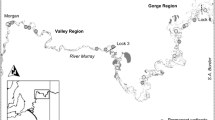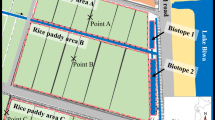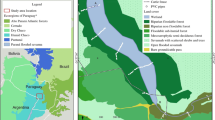Abstract
Globally, rain-fed wetlands provide critical habitat for a wide range of amphibian species, however, information on the use of rain-fed wetlands by Australian frog species is extremely limited. This study examined the distribution of frog breeding in rain-fed wetlands following the first significant rain event after a period of severe drought (2002–2009) in order to predict how frog communities may be affected in the future by changed climate. Tadpole communities along with vegetation and water quality variables were described in 35 rain-fed wetlands across the South West Slopes and Riverina bioregions of inland south-eastern Australia. In addition, weekly tadpole surveys were conducted in a subset of these wetlands to describe temporal patterns of occupancy. Despite the protracted dry period prior to this study 50% of the rain-fed wetlands surveyed contained tadpoles. However, frog communities were species poor with only five species recorded. The majority of wetlands were dominated be a single species, Limnodynastes tasmaniensis which is also common within permanent waterbodies such as farm dams and irrigation infrastructure in both bioregions. Tadpoles of two burrowing species L. interioris and Neobatrachus sudelli were restricted to a small number of wetlands mostly in the South West Slopes. The composition of tadpole communities changed over time, and Crinia parinsignifera was the only species that continued to breed over winter. The dominance of generalist species within rain-fed wetlands indicates that characteristics such as dispersal capability, flexibility in breeding times and the ability to utilise created habitats may be more important than burrowing ability and longevity when predicting vulnerability to climate change.





Similar content being viewed by others
References
Acreman, M. C., J. R. Blake, D. J. Booker, R. J. Harding, N. Reynard, J. O. Mountford & C. J. Stratford, 2009. A simple framework for evaluating regional wetland ecohydrological response to climate change with case studies from Great Britain. Ecohydrology 2: 1–17.
Adams, M. J., 2000. Pond permanence and the effects of exotic vertebrates on anurans. Ecological Applications 10: 559–568.
Anstis, M., 2002. Tadpoles of South-eastern Australia: A Guide with Keys. Reed New Holland, Sydney.
Babbitt, K. J. & G. W. Tanner, 2000. Use of temporary wetlands by anurans in a hydrologically modified landscape. Wetlands 20: 313–322.
Babbitt, K. J., M. J. Baber, D. L. Childers & D. Hocking, 2009. Influence of agricultural upland habitat type on larval anuran assemblages in seasonally inundated wetlands. Wetlands 29: 294–301.
Baber, M. J. & K. J. Babbitt, 2003. The relative impacts of native and introduced predatory fish on a temporary wetland tadpole assemblage. Oecologia 136: 289–295.
Baldwin, R. F. & P. G. deMaynadier, 2009. Assessing threats to pool-breeding amphibian habitat in an urbanizing landscape. Biological Conservation 142: 1628–1638.
Beja, P. & R. Alcazar, 2003. Conservation of Mediterranean temporary ponds under agricultural intensification: an evaluation using amphibians. Biological Conservation 114: 317–326.
Blaustein, A. R., S. C. Walls, B. A. Bancroft, J. J. Lawler, C. L. Searle & S. S. Gervasi, 2010. Direct and indirect effects of climate change on amphibian populations. Diversity 2: 281–313.
Blaustein, A. R., B. A. Han, R. A. Relyea, P. T. J. Johnson, J. C. Buck, S. S. Gervasi & L. B. Kats, 2011. The complexity of amphibian population declines: understanding the role of cofactors in driving amphibian losses. Annals of the New York Academy of Sciences 1223: 108–119.
Boix, D., J. Sala & R. Moreno-Amich, 2001. The faunal composition of Espolla pond (ne Iberian Peninsula): the neglected biodiversity of temporary waters. Wetlands 21: 577–592.
Brock, M. A., R. G. Smith & P. J. Jarman, 1999. Drain it, dam it: alteration of water regime in shallow wetlands on the New England Tableland of New South Wales, Australia. Wetlands Ecology and Management 7: 37–46.
Brodman, R., J. Ogger, T. Bogard, A. J. Long, R. A. Pulver, K. Mancuso & D. Falk, 2003. Multivariate analyses of the influences of water chemistry and habitat parameters on the abundances of pond-breeding amphibians. Journal of Freshwater Ecology 18: 425–436.
Brooks, R., 2009. Potential impacts of global climate change on the hydrology and ecology of ephemeral freshwater systems of the forests of the northeastern United States. Climatic Change 95: 469–483.
Bureau of Meteorology, 2010. Climate Data Online. Commonwealth of Australia, Canberra. http://www.bom.gov.au/climate/data/.
Carroll, E. A., T. H. Sparks, N. Collinson & T. J. C. Beebee, 2009. Influence of temperature on the spatial distribution of first spawning dates of the common frog (Rana temporaria) in the UK. Global Change Biology 15: 467–473.
Casanova, M. T. & M. A. Brock, 2000. How do depth, duration and frequency of flooding influence the establishment of wetland plant communities? Plant Ecology 147: 237–250.
Caughley, J. & B. Gall, 1985. Relevance of zoogeographical transition to conservation of fauna: amphibians and reptiles in the south-western slopes of NSW. Australian Zoology 21: 513–527.
Clarke, K. R. & R. M. Warwick, 2001. Changes in Marine Communities: An Approach to Statistical Analysis and Interpretation. PRIMER-E, Plymouth, UK.
Cogger, H. A., 2000. Reptiles and Amphibians of Australia. Reed New Holland, Sydney.
Dziminski, M. & R. Alford, 2005. Patterns and fitness consequences of intraclutch variation in egg provisioning in tropical Australian frogs. Oecologia 146: 98–109.
Finlayson, C. M. & N. Rea, 1999. Reasons for the loss and degradation of Australian wetlands. Wetlands Ecology and Management 7: 1–11.
Gahl, M. K., A. J. K. Calhoun & R. Graves, 2009. Facultative use of seasonal pools by American bullfrogs (Rana catesbeiana). Wetlands 29: 697–703.
Gillespie, G. & J. Hero, 1999. Potential impacts of introduced fish and fish translocations on Australian amphibians. In Campbell, A. (ed.), Declines and Disappearances of Australian Frogs. Environment Australia, Canberra: 131–144.
Gleason, R., N. Euliss, D. Hubbard & W. Duffy, 2004. Invertebrate egg banks of restored, natural, and drained wetlands in the prairie pothole region of the United States. Wetlands 24: 562–572.
Goldingay, R. L., 2008. Conservation of the endangered Green and Golden Bell Frog: what contribution has ecological research made since 1996? Australian Zoologist 34: 334–349.
Gómez-Rodríguez, C., C. Díaz-Paniagua, L. Serrano, M. Florencio & A. Portheault, 2009. Mediterranean temporary ponds as amphibian breeding habitats: the importance of preserving pond networks. Aquatic Ecology 43: 1179–1191.
Grosner, K. L., 1960. A simplified table for staging anuran embryos and larvae with notes on identification. Herpetologica 16: 183–189.
Harrison, S., 1994. Metapopulations and conservation. In Edwards, P. J., R. M. May & N. R. Webb (eds), Large-Scale Ecology and Conservation Biology. Blackwell Science, Oxford: 111–128.
Hazell, D., R. Cunnningham, D. Lindenmayer, B. Mackey & W. Osborne, 2001. Use of farm dams as frog habitat in an Australian agricultural landscape: factors affecting species richness and distribution. Biological Conservation 102: 155–169.
Homan, R. N., B. S. Windmiller & J. M. Reed, 2004. Critical thresholds associated with habitat loss for two vernal pool-breeding amphibians. Ecological Applications 14: 1547–1553.
Jakob, C., G. Poizat, M. Veith, A. Seitz & A. J. Crivelli, 2003. Breeding phenology and larval distribution of amphibians in a Mediterranean pond network with unpredictable hydrology. Hydrobiologia 499: 51–61.
Jolly, I. D., K. L. McEwan & K. L. Holland, 2008. A review of groundwater-surface water interactions in arid/semi-arid wetlands and the consequences of salinity for wetland ecology. Ecohydrology 1: 43–58.
Kayes, S. M., R. L. Cramp, N. J. Hudson & C. E. Franklin, 2009. Surviving the drought: burrowing frogs save energy by increasing mitochondrial coupling. Journal of Experimental Biology 212: 2248–2253.
Lane, S. J. & M. J. Mahony, 2002. Larval Anurans with synchronous and asynchronous development periods: contrasting responses to water reduction and predator presence. Journal of Animal Ecology 71: 780–792.
Lee Foote, A. & C. L. Rice Hornung, 2005. Odonates as biological indicators of grazing effects on Canadian prairie wetlands. Ecological Entomology 30: 273–283.
Lemckert, F. & M. Mahony, 2008. Core calling periods of the frogs of temperate New South Wales, Australia. Herpetological Conservation and Biology 3: 71–76.
Mac Nally, R., G. Horrocks, H. Lada, P. S. Lake, J. R. Thomson & A. C. Taylor, 2009. Distribution of anuran amphibians in massively altered landscapes in south-eastern Australia: effects of climate change in an aridifying region. Global Ecology and Biogeography 18: 575–585.
Mazerolle, M. J. & M. A. Villard, 1999. Patch characteristics and landscape context as predictors of species presence and abundance: a review. Ecoscience 6: 117–124.
McMenamin, S. K., E. A. Hadly & C. K. Wright, 2008. Climatic change and wetland desiccation cause amphibian decline in Yellowstone National Park. P. Natl. Acad. Sci. USA 105: 16988–16993.
Murphy, B. F. & B. Timbal, 2008. A review of recent climate variability and climate change in southeastern Australia. International Journal of Climatology 28: 859–879.
Neveu, A., 2009. Incidence of climate on common frog breeding: long-term and short-term changes. Acta Oecologica 35: 671–678.
Patla, D. A., C. R. Peterson & P. S. Corn, 2009. Amphibian decline in Yellowstone National Park. Proceedings of the National Academy of Sciences 106: E22.
Paton, P. W. C. & W. B. Crouch, 2002. Using the phenology of pond-breeding amphibians to develop conservation strategies. Conservation Biology 16: 194–204.
Pearson, R. G. & T. P. Dawson, 2003. Predicting the impacts of climate change on the distribution of species: are bioclimate envelope models useful? Global Ecology and Biogeography 12: 361–371.
Penman, T. D., F. L. Lemckert & M. J. Mahony, 2004. Meteorological effects on the activity of the giant burrowing frog (Heleioporus australiacus) in south-eastern Australia. Wildlife Research 33: 35–40.
Piha, H., M. Luoto, M. Piha & J. Merila, 2007. Anuran abundance and persistence in agricultural landscapes during a climatic extreme. Global Change Biology 13: 300–311.
Popescu, V. D. & J. P. Gibbs, 2009. Interactions between climate, beaver activity, and pond occupancy by the cold-adapted mink frog in New York State, USA. Biological Conservation 142: 2059–2068.
Rohr, J. R. & D. M. Madison, 2003. Dryness increases predation risk in Efts: support for an amphibian decline hypothesis. Oecologia 135: 657–664.
Rohr, J. R. & T. R. Raffel, 2010. Linking global climate and temperature variability to widespread amphibian declines putatively caused by disease. Proceedings of the National Academy of Sciences 107: 8269–8274.
Schauble, C. S., 2004. Variation in body size and sexual dimorphism across geographical and environmental space in the frogs Limnodynastes tasmaniensis and L. peronii. Biological Journal of the Linnean Society 82: 39–56.
Semeniuk, C. A. & V. Semeniuk, 1995. A geomorphic approach to global classification for inland wetlands. Plant Ecology 118: 103–124.
Smith, I. & E. Chandler, 2010. Refining rainfall projections for the Murray Darling Basin of south-east Australia—the effect of sampling model results based on performance. Climatic Change 102: 377–393.
Smith, M. A. & D. M. Green, 2005. Dispersal and the metapopulation paradigm in amphibian ecology and conservation: are all amphibian populations metapopulations? Ecography 28: 110–128.
Thomas, C. D., A. Cameron, R. E. Green, M. Bakkenes, L. J. Beaumont, Y. C. Collingham, B. F. N. Erasmus, M. F. de Siqueira, A. Grainger, L. Hannah, L. Hughes, B. Huntley, A. S. van Jaarsveld, G. F. Midgley, L. Miles, M. A. Ortega-Huerta, A. Townsend Peterson, O. L. Phillips & S. E. Williams, 2004. Extinction risk from climate change. Nature 427: 145–148.
Todd, B. D., D. E. Scott, J. H. K. Pechmann & J. W. Gibbons, 2010. Climate change correlates with rapid delays and advancements in reproductive timing in an amphibian community. Proceedings of the Royal Society B: Biological Sciences: Published online before print December 15, 2010.
Tracy, C. R., S. J. Reynolds, M. C. McArthur, R. Tracy & K. A. Christian, 2007. Ecology of Aestivation in a cocoon-forming frog, Cyclorana australis (Hylidae). Copeia 4: 901–912.
Trauth, J. B., S. E. Trauth & R. L. Johnson, 2006. Best management practices and drought combine to silence the Illinois Chorus Frog in Arkansas. Wildlife Society Bulletin 34: 514–518.
Vignoli, L., M. A. Bologna & L. Luiselli, 2007a. Seasonal patterns of activity and community structure in an amphibian assemblage at a pond network with variable hydrology. Acta Oecologica-International Journal of Ecology 31: 185–192.
Vignoli, L., M. A. Bologna & L. Luiselli, 2007b. Seasonal patterns of activity and community structure in an amphibian assemblage at a pond network with variable hydrology. Acta Oecologica 31: 185–192.
Wassens, S., 2006. Frog communities of the Murrumbidgee Irrigation Area, NSW. In Taylor, I. R., P. A. Murray & S. G. Taylor (eds), Wetlands of the Murrumbidgee River Catchment: Practical Management in an Altered Environment. Fivebough and Tuckerbil Wetlands Trust, Leeton, NSW: 86–95.
Wassens, S., R. J. Watts, A. Jansen & D. Roshier, 2008. Movement patterns of Southern Bell Frogs (Litoria raniformis) in response to flooding. Wildlife Research 35: 50–58.
Williams, W. D., 1985. Biotic adaptations in temporary lentic waters, with special reference to those in semi-arid and arid regions. Hydrobiologia 125: 85–110.
Williamson, I. & C. M. Bull, 1999. Population ecology of the Australian frog Crinia signifera: larvae. Wildlife Research 26: 81–99.
Acknowledgements
David Read (Wagga Wagga City Council) and Dr Patricia Murray (Murrumbidgee Catchment Management Authority) greatly assisted in the identification and selection of survey wetlands. Two anonymous reviewers provided valuable advice which greatly improved the quality of this article. Vanessa Griese and Sarah Cordell assisted with data collection. We thank land holders for giving us access to study sites on their property. This research was conducted under a NSW National Parks and Wildlife Service Licence (S12393). Ethics approval was granted by Charles Sturt University Animal Care and Ethics Committee (10/042).
Author information
Authors and Affiliations
Corresponding author
Additional information
Guest editor: C. Max Finlayson / Wetlands and climate change: ecological outcomes and adaptation as shown by Australian case studies
Rights and permissions
About this article
Cite this article
Wassens, S., Walcott, A., Wilson, A. et al. Frog breeding in rain-fed wetlands after a period of severe drought: implications for predicting the impacts of climate change. Hydrobiologia 708, 69–80 (2013). https://doi.org/10.1007/s10750-011-0955-2
Received:
Accepted:
Published:
Issue Date:
DOI: https://doi.org/10.1007/s10750-011-0955-2




